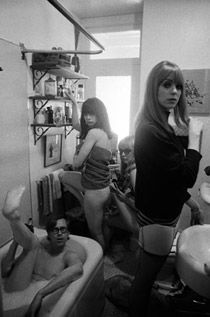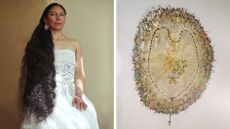Book: Dennis Hopper: Photographs 1961-1967

Inspired by his friend James Dean, Dennis Hopper explains his new monograph this way, “I was doing something that I thought could have some impact someday. In many ways, it’s really these photographs that kept me going creatively."

See more images from Dennis Hopper’s latest photographic monograph
In 1955, an 18-year-old Hopper met 24-year-old Dean on the set of Rebel Without a Cause and the two became immediately inseparable. Prior to his death, in fact, it was Dean who advised Hopper to start taking photographs. Who knows if Dean had any idea where his suggestion might lead, but on the eve of the book's release, it’s clear the art world is better for it.
In recent years, Hopper the photographer has even eclipsed Hopper as a film star and the publication shows that photography has been a pillar of Hopper’s creative world for decades. Featuring several previously unpublished photographs, his images are a dramatic visual treatment of the 1960s, reflecting a world in flux—politically, socially and artistically.
From the civil rights march at Selma to the art world’s electricity to grittier, urban street scenes, from politicians to writers to artists to complete strangers, Hopper’s camera captured an era. His photos also reveal the circles in which he himself moved, with intimate portraits of personalities like Andy Warhol, James Dean, Tina Turner, Paul Newman and Jane Fonda. Insightful essays plus interviews with Hopper, his famous subjects, friends and family add another layer of indulgence to the experience.
Hopper’s photographs unarguably share the same intensity and intelligence that marked his film career for over five decades. It makes it difficult to completely separate his cinematic career from his photographic career—but really, why should we? As Walter Hopps writes in the book, “His good pictures seem in the best sense like films, as these evocative recordings of his experiences and his travels.”
by Anna Carnick
Wallpaper* Newsletter
Receive our daily digest of inspiration, escapism and design stories from around the world direct to your inbox
-
 Frank Stephenson’s high-flying capsule design for HALO’s balloon-powered space flights
Frank Stephenson’s high-flying capsule design for HALO’s balloon-powered space flightsSpace start-up HALO promises zero-emission travel to the stratosphere in a futuristic viewing capsule shaped by Frank Stephenson Design
By Jonathan Bell Published
-
 Back to Black: all eyes on film-maker Sam Taylor-Johnson
Back to Black: all eyes on film-maker Sam Taylor-JohnsonBack to Black cinematographer Polly Morgan tells Wallpaper* how a shared love of French New Wave close-ups brought Sam Taylor-Johnson’s Amy Winehouse biopic to life
By Craig McLean Published
-
 Formafantasma’s new collection explores nostalgia and the queer identity
Formafantasma’s new collection explores nostalgia and the queer identityFormafantasma present 'La Casa Dentro' at Fondazione ICA Milano (until 19 July 2024), where they draw inspiration from the domestic sphere and their own nostalgic perceptions of home
By Laura May Todd Published
-
 ‘Package Holiday 1968-1985’: a very British love affair in pictures
‘Package Holiday 1968-1985’: a very British love affair in pictures‘Package Holiday’ recalls tans, table tennis and Technicolor in Trevor Clark’s wistful snaps of sun-seeking Brits
By Caragh McKay Published
-
 ‘Art Exposed’: Julian Spalding on everything that’s wrong with the art world
‘Art Exposed’: Julian Spalding on everything that’s wrong with the art worldIn ‘Art Exposed’, Julian Spalding draws on his 40 years in the art world – as a museum director, curator, and critic – for his series of essays
By Alfred Tong Published
-
 Marisol Mendez's ‘Madre’ unpicks the woven threads of Bolivian womanhood
Marisol Mendez's ‘Madre’ unpicks the woven threads of Bolivian womanhoodFrom ancestry to protest, how Marisol Mendez’s 'Madre' is rewriting the narrative of Bolivian womanhood
By Sofia de la Cruz Published
-
 Photo book explores the messy, magical mundanity of new motherhood
Photo book explores the messy, magical mundanity of new motherhood‘Sorry I Gave Birth I Disappeared But Now I’m Back’ by photographer Andi Galdi Vinko explores new motherhood in all its messy, beautiful reality
By Hannah Silver Published
-
 Best contemporary art books: a guide for 2023
Best contemporary art books: a guide for 2023From maverick memoirs to topical tomes, turn over a new leaf with the Wallpaper* arts desk’s pick of new releases and all-time favourite art books
By Harriet Lloyd-Smith Published
-
 The best photography books for your coffee table
The best photography books for your coffee tableFlick through, mull over and deep-dive into the best photography books on the market, from our shelves to you
By Sophie Gladstone Published
-
 Behind the scenes of Stanley Kubrick’s The Shining: new book charts the making of a horror icon
Behind the scenes of Stanley Kubrick’s The Shining: new book charts the making of a horror iconPublished in February 2023 by Taschen, a new collector's book will go behind the scenes of Stanley Kubrick’s The Shining, charting the unseen making of a film that defined the horror genre
By Harriet Lloyd-Smith Published
-
 Brad Walls’ aerial view transforms pools into artwork
Brad Walls’ aerial view transforms pools into artworkAerial photographer Brad Walls provides a crisp conclusion to the summer months with new book Pools From Above – you’ll want to dive right in
By Martha Elliott Last updated